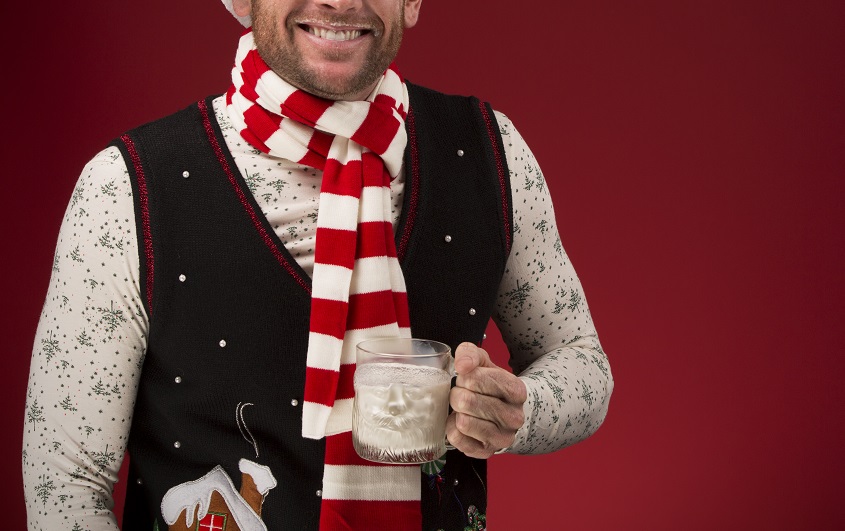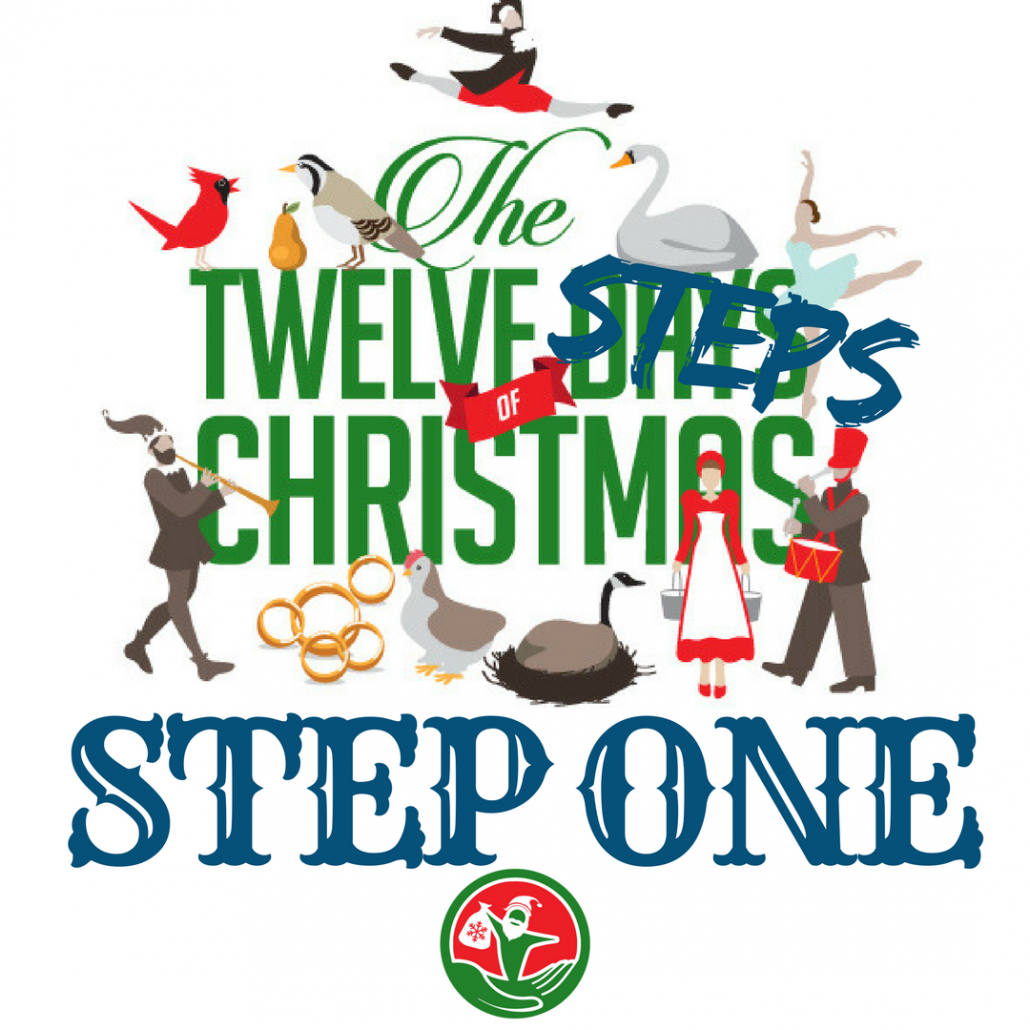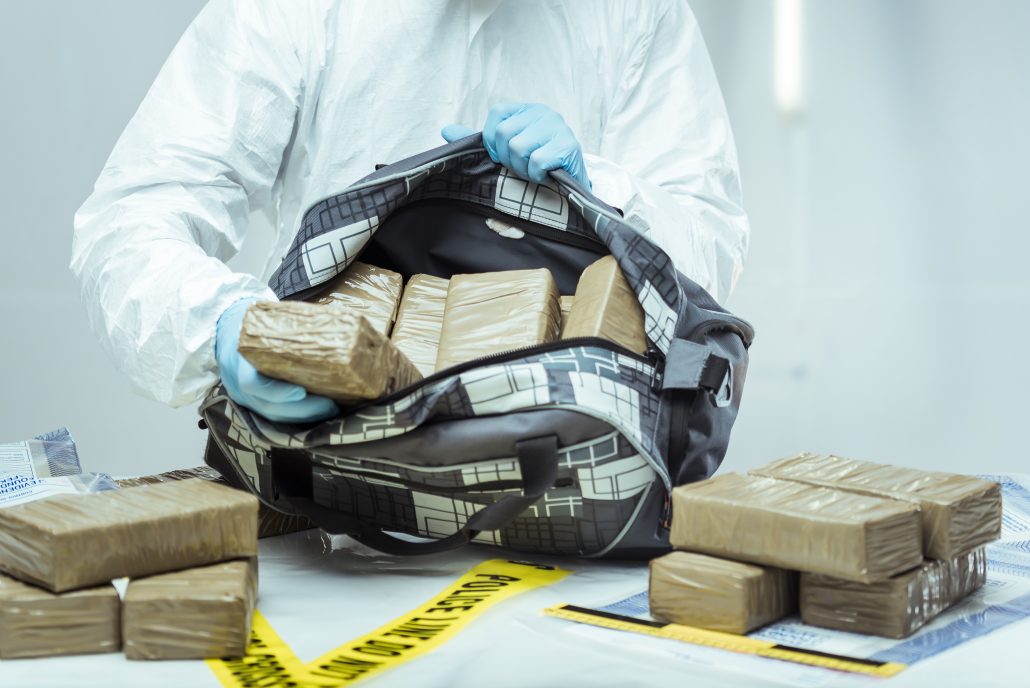by staff | Dec 18, 2017 | Alcoholics Anonymous, Christmas, Coping Skills, Family, Holiday, Recovery, Sober Fun, Sobriety

(This content is being used for illustrative purposes only; any person depicted in the content is a model)
Welcome to another exciting edition of the 12 Steps of Christmas; our own take on the classic Christmas carol, with a sobriety-themed twist to try and bring some more compassion and insight to a cheerful time of year for those of us in recovery from drugs or alcohol. Substance use and addiction can make the season a tough time, but we want to help anyone who may be struggling or just people in recovery who need a little inspiration, to get in the right state of mind for the holiday.
Of course, we want to hear your feedback, and we are happy to share with our followers and friends more of the 12 Steps of Christmas.
 Step 2: Came to believe a Power Greater than myself could restore my holiday cheer
Step 2: Came to believe a Power Greater than myself could restore my holiday cheer
You may remember that in Step 1 of Christmas we talked about unmanageability and about how the holidays and our loved ones are pretty much out of our control. So then what do we do?
Well, for this one the 2 turtle doves probably aren’t going to cut it. For those familiar with the 12 Steps used in many recovery fellowships, there comes the concept of believing a Power Greater than yourself can help you out. Now for some, this can be the most difficult aspect of 12 Step programs because any implication of concepts like faith or spirituality can create contempt or frustration. People may resist this idea, thinking it is pushing a certain god or religion onto them.
Some people think Santa is more realistic than a god. Well, fine… try delivering presents to all the nice kids in the world in one night with only a few reindeer and a belly full of Oreo cookies! Now THAT is a power greater than you, for sure!
St. Nicholas with the mic drop!
We are not here to argue the idea of any god. We aren’t trying to force anyone into some kind of religious epiphany or preach any gospels. But, for those who are open to exploring the idea of a Higher Power; it can be extremely helpful when we talk about the struggles we face during stressful holidays.
Step 2 is all about finding the willingness to believe something outside of yourself can help you through this holiday. Sure, you should also be aware of yourself and your actions. But be open to the idea that you don’t have to force the holiday to be special, it just is.
Tis the season for believin’ dude!
Rejoicing without religion…
Now, of course, one thing is that not everyone celebrates Christmas in the first place. Different religions and cultures celebrate in various ways during this time of year.
We are pleased to wish everyone a Happy Chanukah, a Joyous Kwanzaa, and everything in between. In no way are we saying sobriety depends on your commitment to a faith during any holiday. For those who find themselves celebrating Christmas, there can be a great deal of diversity in how you celebrate and why. Even though is it historically a Christian holiday, plenty of non-Christians, atheists, and agnostics still celebrate. According to the 2014 General Sociological Survey:
- 21% of the American population does not identify with a religion
Younger people tend to be the majority of these trends. Yet, according to a new Pew Research Center survey:
- 90% of Americans celebrate Christmas
- 95% of Christians say they celebrate Christmas
- Only 46% of Americans say they celebrate as primarily a religious (rather than cultural) holiday, down from 51% who said this in 2013
So, with so many people not subscribing to the traditional guidelines of the Christianity, there are plenty of ways to celebrate Christmas without needing to fall in line. In early recovery, a lot of people are still trying to find a foundation to build some kind of understanding of spiritual concepts. So now isn’t the time to push them too hard in one direction or another. Just use this time as a chance to be more open to the joy and cheer that come your way.
You don’t have to be “spiritual” to be in the Christmas spirit…
For those who consider themselves spiritual or faithful, connection with your Higher Power can be the key to getting through the holidays. Some may view this time of year as a specific celebration of their faith and therefore should take every opportunity to remind themselves through the difficulties they face in recovery to appreciate and honor that connection to family and friends.
For those who do not consider themselves spiritual or faithful, you might even consider the holiday itself to be a source of power. The energy and the atmosphere it creates between people might be just enough to help you feel even more compassion and connection to those you love. Even if people don’t want to spend their Christmas in church or in prayer, you can still take the time to connect with your family and friends. Maybe that is what will restore your holiday cheer; the love you have with those you are close to. It doesn’t have to be a god or a faith, just be grateful and present for these moments.
Recovery from substance use disorder gives us the opportunity to cherish things and celebrate life in a new way. Believing that something bigger than you, even if it just Santa Clause or the Christmas spirit, can help bring the joy back into experiencing the holidays with your family and friends. Try to appreciate the chance to be clean, sober and with the people who mean the most to you. If nothing else, that is powerful beyond measure.
And leave some cookies and milk out… just in case.
Take some time this year to be open to the joy of the holidays, even if you don’t know where that cheer comes from. If you are struggling this holiday season, ask for help; not just for your family but, for yourself. Give yourself and those who love you the most the best gift you can. If you or a loved one is struggling with substance abuse or addiction, please call toll-free now.
CALL NOW 1-888-922-5398
by staff | Dec 15, 2017 | Addiction, Christmas, Family, Holiday, Recovery, Sobriety

(This content is being used for illustrative purposes only; any person depicted in the content is a model)
In the spirit of the holiday season, we figure it is about time to not only celebrate love, giving and connection but also a time to celebrate the journey into sobriety many amazing people are on all around the world. As we reach the end of another interesting and exciting year, full of bittersweet memories as well as joy and hope, we thought it would be nice to give a sobering spin on one of the Christmas classics; the 12 days of Christmas. But honoring the legacy of 12 Step fellowships that have been such a life-changing foundation for many people recovering from drugs or alcohol.
We know that the holidays can also be a difficult time for those who may be separated from their loved ones for the season. They can certainly be a difficult time for those who are still struggling or who have loved ones suffering. So we want to spread a little bit of hope along with holiday cheer.
So for the days leading us to Christmas, we look forward to presenting all of our incredible followers and friends with our very own version of the 12 Steps of Christmas.
 Step 1: Admitting that I am powerless over the Holidays and they can make my life unmanageable
Step 1: Admitting that I am powerless over the Holidays and they can make my life unmanageable
Forget the partridge in the pear-tree for the first day… let’s start off slow.
The fact is, the holidays will come around whether we are ready for them or not. I’m still trying to figure out how I survived the turkey and stuffing from November. Then BOOM here comes Christmas, with the gift giving and the family time and all that fun stuff. With all the tinsel and toys (yes, I still ask Santa for Batman action figures for Christmas) there comes a lot of stress and temptations for some people in sobriety.
Remembering Christmas with drinking…
Sometimes they want to join in “merriment” is pretty tempting. I know personally, the temptation to drink during Christmas was pretty much the same as every other 24 hours in early recovery; a lot. Lucky me, I got to spend my first sober Christmas in a holistic addiction treatment program. NICE! In all seriousness, it probably did save my life.
But I can remember the days when I used to drink with my loved ones on Christmas. After getting through the presents and coming together in the afternoon to spend time together, we would have food and drink together. The only problem, maaaaaybe some of us (ME) drank a little too much of the eggnog.
Whether or not you are a fan of “eggnog”, which in some families (or maybe just my family) tends to have a hearty serving of whiskey in the mix, there can be plenty of things about the holiday season that are tough to tussle with, especially in early sobriety.
Powerless over family…
We have to remember that our families are out of our control. All that dysfunction and colorful history with all the characters you call relatives can be, to put it mildly, exhausting and stressful. Sometimes our family members want to remind us of all the time we spent last year nodding out at Christmas dinner…
…or the time we threw up on the snowman in the backyard…
…or the time we sold all the presents under the tree and disappeared for a week…
…No? Just me?
Anyway, the truth is that when aunts, uncles, cousins, and siblings all come together with the parents and grandparents and so on, reminiscing is just part of the package. Maybe for some (me, apparently), it is more painful than others. Or perhaps, maybe you still have that family member that is struggling. Perhaps they are the ones disappearing for days, drinking too much cider or even causing conflict due to their distressed state in active addiction. It can be incredibly disheartening.
Either way, it is important to remember that we are not in control of our loved ones. Early recovery for a lot of us is about learning acceptance and working through the adversities we face with humility. Family support in the recovery process is more important than most people realize.
Plus, an abundance of Christmas cookies can go a long way.
Working with that unmanageability…
The most important part of any holiday, especially this time of year, is the compassion and goodwill toward others this season is meant to inspire in us. As troubling as life can be, our efforts to share love and connection are the best way to work through that obstinacy.
No matter how unmanageable the family get-together can be, in recovery, we have to try and remind ourselves that all we are responsible for is giving as much love, compassion, and acceptance as we can, while still maintaining healthy boundaries.
So step 1 for the 12 Steps of Christmas is essentially trying to remember not to stress the small stuff, and to accept yourself and your loved ones.
As for the partridge… is that even a thing? Who has a spare pear tree these days anyway?
Spending Christmas facing the hurdles and hardships of addiction can be a daunting task, but take this opportunity to be more aware of what truly matters and what that means for your recovery. For those struggling this holiday season, ask for help; not just for your family but, for yourself. Give yourself and those who love you the most the best gift you can. If you or a loved one is struggling with substance abuse or addiction, please call toll-free now.
CALL NOW 1-888-922-5398
by Justin Mckibben | Dec 7, 2017 | Carfentanil, Drug Abuse, Fentanyl, Fentanyl, News, Opioids, Synthetic Drugs

In 2014 the state of Ohio was #2 for most overdose deaths in all of America with approximately 2,744 deaths. For 2016 early estimates are putting that number at 4,149 Ohioans who lost their lives, a 36% climb from 2015, the year when the Buckeye State had by far the most overdose deaths in the nation.
On average, 11 people died every day from heroin, fentanyl, carfentanil and other drugs in Ohio through 2016.
As the nation grapples with these skyrocketing body counts from coast to coast, more government and law enforcement officials are trying to find new ways to take action against the opioid crisis. For those who do not know, fentanyl is a synthetic opioid; one of the most dangerous drugs on the illicit market.
But recently the Capital City of the Midwest has scored a huge win in that fight.
Enough to Kill Columbus
Back in October one drug bust led to investigators discovering 2 kilograms, or 4.5 pounds, of fentanyl in the trunk of a car. To put this in perspective, the Franklin County Prosecutor Ron O’Brien stated that:
- A fatal dose of fentanyl is considered to be only 2-3 milligrams.
- In Columbus, Ohio the population is approximately 860,000 people.
Crunching the numbers, the prosecutor points out this amount of the incredibly lethal synthetic drug could have killed every man, woman, and child in the city.
Three California men were arrested in relation to this bust.
Enough to Kill Ohio
Just when you think you’ve heard the worst of it, that’s not even the tip of the iceberg. The following month police in the capital city seized 20 pounds of pure fentanyl. In regards to this case, Ron O’Brien said,
“So it would probably be enough to kill all, the entire population in the state of Ohio.”
Again, using the same lethal fentanyl dosage for perspective, Ohio has 11.6 million residents. The amount of fentanyl discovered in the November bust could potentially kill more than 9 million people. O’Brien included,
“Two or three milligrams of fentanyl is not much more than five or six small grains of salt.”
So it stands to reason that 20 pounds of this drug could easily wipe out the vast majority of the inhabitants of the state.
More Record Busts this Year
The opioid epidemic is the greatest drug crisis in the history of the country. As the problem has intensified, the spread of fentanyl and carfentanil has continued to bring dead and devastation. Luckily, there are more major opioid busts this year, with some seizing enough fentanyl to kill entire populations of several states.
New York
In August officials of the Empire State managed to seize more than 140 pounds of fentanyl in August. The Drug Enforcement Administration said that amount could’ve killed nearly 32 million people. Put more bluntly, this amount of fentanyl could wipe out the populations of Texas and Oklahoma… combined!
San Diego
Back in June officials in this major California city found close to 100 pounds of fentanyl. That is enough to kill 22.4 million people; that is the combined populations of:
- New York
- New Hampshire
- Maine
St. Louis
The Gateway to the West was able to catch nearly 60 pounds of pure fentanyl back in April. That alone is enough to kill more than 13.6 million people.
Fighting the Spread of Fentanyl
Back in Ohio, Ron O’Brien and other officials know the opioid epidemic is getting worse all over the country. The Center for Disease Control and Prevention’s latest drug report states:
- More than 33,000 people died from opioid-related drug overdoses in 2015
- Close to 10,000 of them were from synthetic opioids such as fentanyl
In the state of Ohio, the opioid crisis has placed an increasing strain on resources. Financially it is costing Ohio residents between $6.6 and 8.8 billion per year, according to some experts. That is almost as much as the state spends on education for grades K-12.
Yet the fight goes on.
These massive seizures of this lethal synthetic chemical have undoubtedly saved many lives. However, putting a complete stop to the illicit drug trade is still very far off, if at all possible. Still, taking a few hundred pounds of such a potent and potentially deadly drugs off the streets makes an immeasurable difference.
For more important information on the dangers of prescription drugs, download our FREE E-BOOK “Big Secrets of Big Pharma: Why They Secretly Hope You Get Hooked”
DOWNLOAD FREE E-BOOK
Treating Opioid Abuse
Holistic drug addiction treatment is an effective and important resource for helping people struggling with substance use disorder, especially in the wake of the opioid crisis in America.
Outbreaks of more life-threatening drug problems including fentanyl and other hazardous synthetics only make the need for supportive and impactful treatment more relevant. If we want to overcome the opioid epidemic there must be an emphasis on how we treat people struggling and on how we support them through the recovery process.
Treating opioid abuse is about building a strong foundation with safe medical detox, personalized therapy, and innovative treatment opportunities. Palm Healthcare Company helps thousands of people all over the country overcome opioid abuse. Our facilities are committed to providing quality care for those dealing with drug abuse, whether it is illicit drugs or prescription drug dependence. If you or someone you love is struggling, please call toll-free now. We want to help.
CALL NOW 1-888-922-5398
by Justin Mckibben | Dec 1, 2017 | Addiction Stigma, Donald Trump, Drug Policy, Fentanyl, Heroin, Law Enforcement, News, Opioids, Prescription Drugs

This past Wednesday, Attorney General Jeff Sessions made the announcement that White House counselor Kellyanne Conway will be the Trump administration’s go-to for opioid crisis efforts. This announcement has been met with both praise and criticism. Some say this appointment actually gives validity to the White House’s commitment to solving the ongoing opioid epidemic, while others see it as the exact opposite.
For a little background, Kellyanne Conway worked as a pollster before becoming Trump’s campaign manager during his run for the 2016 presidential nomination. Currently, Conway serves as a White House spokeswoman and Trump surrogate. She has been seen on countless panels discussing the biggest topics and politics. She absolutely has her work cut out for her, so can Kellyanne Conway compete?
The Kellyanne Cons and Pros
So can this infamous Trump advocate, the woman who practically accidentally coined the phrase “alternative facts” compete with the opioid crisis in America? Kallyanne Conway has become notorious for defending some of President Trump’s most flagrant and controversial “alternative facts” in the media. But in her defense, she also has said some things that seem to highlight important prospects for this problem.
So here are some things to consider when we talk about Kellyanne Conway being put in charge of the opioid epidemic.
Lack of Experience
One of the big problems with this appointment people are pointing out is the lack of experience. Critics say this appointment speaks to how little passion the current administration is actually putting into fighting the opioid crisis since Kellyanne Conway has no experience in public health or with drug policy.
But in a time where Americans seem to be putting more trust in people that don’t typically meet the description of “qualified” in hopes that an outsider might bring better results, it makes sense that a lot of people might still hope Kellyanne can do some good.
Yet, there are still those who aren’t so sure. Tom Synan, a police chief and member of the Hamilton County Heroin Coalition in Ohio tweeted in response to the announcement:
“Ummm… did we run out of Dr’s, cops, addiction specialists or people who are actually dealing with this on the street to lead this?”
As a first responder, Synan is one of many people who are frustrated with the current actions being taken.
“I don’t want to get involved in politics, but it seems like it is a political position … I think I would have gone out to the country and tapped into people who are national experts who are on the street who are literally dealing with this issue every day,”
It seems many on the front lines are not impressed with the Trump administration’s move to put Kellyanne Conway in charge of efforts to combat one of the worst drug problems in the nation’s history.
Publicity and Perception
During a press briefing about the Justice Department’s efforts to combat the crisis where the announcement was made, Sessions said President Donald Trump chose Kellyanne Conway to “change the perception” about opioids and reduce addictions and deaths.
According to Sessions, President Trump has made the epidemic “a top priority for his administration, including every senior official and Cabinet member.”
An opioid policy expert Andrew Kolodny of Brandeis University actually defended the move when speaking to BuzzFeed News, stating:
“It is a positive sign. She is a high-profile figure in the administration, showing the administration takes this seriously,”
Some believe this can offer a sign of hope for more concrete action since many recovery advocates say despite the declaration of a public health emergency from President Trump there has been very little action taken to change the state of the epidemic.
Bertha Madras, a member of the President’s Commission on Combating Drug Addiction and the Opioid Crisis and Harvard Medical School professor, said:
“The most important thing that Kellyanne Conway will provide is access … but also commitment… She was at all the meetings, she listened and took copious notes.”
Let’s hope those are some good notes because thus far the opioid problem in America has shown no signs of slowing down. Jeff Sessions justified the appointment by saying Kellyanne Conway “understanding messaging” and can help turn around public perception. But is this about publicity, or is it about the preservation of life?
Surely breaking the stigma and changing the way addiction is viewed does matter, but should someone who specializes in making things look good to be in charge of how this country deals with one of the most prominent crises we face?
Treatment and Resources
Kellyanne does seem to support treatment, but to what extent it is still unclear. In one interview with ABC Kellyanne Conway did say,
“Pouring money into the problem is not the only answer. We have to get serious about in-facility treatment and recovery.”
So she at least appears to understand how crucial effective inpatient treatment is for recovery.
But when reporters mentioned the fact that there needs to be funding for these programs, she put more emphasis on “a 4 letter word called will” that seems to side-step the question- where will these resources come from?
As it now stands, White House has:
- Left the leadership role of the Office of National Drug Control Policy vacant
- Failed to release any written opioid-control strategy
- Not requested funds to replenish the national public health emergency fund that currently sits at just $66,000
In fact, President Trump’s 2018 budget request would increase addiction treatment funding by less than 2%. And don’t be fooled, that increase includes the $500 million already appropriated by Congress in 2016 under the 21st Century Cures Act with the Obama administration.
Even Chris Christie, the Republican New Jersey Governor who led the White House Opioid Commission, said:
“In New Jersey, we are spending $500 million,” he said. “I am not, quite frankly, impressed with $1 billion from the federal government for the nation.”
Strict Prevention and Punishment
When you look at what she has said on record in regards to opioids and addiction, it doesn’t really inspire a great deal of confidence. Kellyanne Conway has consistently hinted to an outdated ideology of what addiction is and how to address it.
In the past, Kellyanne has said,
“The best way to stop people dying from overdoses and drug abuse is by not starting in the first place… That’s a big core message for our youth.”
That’s right; just say no.
Critics say this aligns with the mindset of Jeff Sessions and others in the White House who seem to think that ‘Just Say No’ tactics actually work, or that purely prevention-based programs like D.A.R.E. can solve the whole problem. While prevention is important, it has proven to be ineffective as a focal point when addressing addiction.
Circling back to publicity, what Ms. Conway does seem to heavily endorse is a White House investigation for a “national ad campaign” on abuse prevention. President Trump himself had voiced his own support for a national advertising initiative to try and deter drug use.
But we all remember those commercials- this is your brain on drugs- and they didn’t really help that much.
Again, it seems Attorney General Sessions and the current administration is more focused on punishment than treatment and strict law enforcement. Sessions said the Justice Department was giving more than $12 million in grants to state and local law enforcement to help them prosecute crimes connected to:
Sessions is also ordering all U.S. Attorney offices to designate opioid coordinators. Kaitlyn Boecker, Policy Manager with the Drug Policy Alliance, has been vocal in her disapproval of the current steps being taken.
“Despite declaring the opioid overdose crisis a public health emergency just last month, the Trump Administration continues to emphasize failed prohibitionist policies while ignoring proven public health measures that we know reduce overdose death, like community naloxone distribution.”
“As we feared, the Administration is using the overdose crisis as an excuse to ratchet up the war on drugs rather than an opportunity to save lives.”
At this point, we can say that the news is not without skeptics. While many are still trying to remain hopeful that maybe because Kellyanne is so vocal and such a well-known surrogate for the president that perhaps she will be able to garner more attention to the issue.
While the fight for more resources continues, we should always encourage people to seek help. There are many safe and effective treatment resources already that have been helping people recover from drug and alcohol addiction for decades, like Palm Healthcare Company. If you or someone you love is struggling, please call toll-free now. We want to help.
CALL NOW 1-888-922-5398

 Step 2: Came to believe a Power Greater than myself could restore my holiday cheer
Step 2: Came to believe a Power Greater than myself could restore my holiday cheer 
 Step 1: Admitting that I am powerless over the Holidays and they can make my life unmanageable
Step 1: Admitting that I am powerless over the Holidays and they can make my life unmanageable


